The Great Grant Knit-a-Thon
By Dean W Veall, on 18 August 2015
12 hours in the Museum knitting – why – I hear you ask? Dean Veall here and another installment of Museum Events. As part of the Strange Creatures: The art of unknown animals exhibition events series we decided to run an event that took inspiration from co-curator Sarah Wade’s research, and the display of artist Ruth Marshall’s knitted skin of a Thylacine. We set the knitters of London the challenge of knitting some of the strange creatures from our collection. Visitors could bring their own knitting needles to ‘stitch one purl one’ for an hour over lunch or come after work and join in over a glass of wine.
The Great Grant Knit-a-Thon
Tuesday 19th May, 10am to 10pm
Demonstration
What Happened
Much fun is what! None of us here in the Museum had the necessary skills to deliver such a making event; personally my hand eye co-ordination leaves a lot to be desired! So we looked for a partner group and we got lucky when East London yarning collective, Prick Your Finger, were receptive to the idea of a museum based knit-a-thon.
Rachael Matthews, who runs the collective, was with us from kick off at 10am and stayed right up to close at 10pm. She brought along with her three very talented and passionate crafts people (knitters and crochetiers) who supported the more novice knitters who arrived later in the day during our normal opening hours. As the event was inspired by Ruth Marshall’s knitted thylacine skin, we offered participants to create one of her Leadbeaters possums from her original pattern, which is what the more expert knitters did who arrived at the stroke of 10am. Part of the collective is Max Alexander. Max creates amazing moth creations out of wool and brought some of those with her, which we displayed alongside some of Lepidoptera collections. As we got off to a slow start Max got stuck in and crocheted her own flying fish.
As the day went on we developed a core of knitters including some from the prestigious London Knitters Guild, who studiously knitted away oblivious to the visitors to the Museum, deep in knitting thought creating what would be some amazing beasts. But many general Museum visitors picked up needles for the first time as they encountered the knitters and with gentle encouragement from the tutors and had a good go a knitting some patterns, with a few ending up staying several hours instead of the 30 minutes they had intended. One of our own exhibition volunteers, a self-professed novice, started a possum which slowly mutated into a great looking squid.
Putting the whole event into context was exhibition co-curator Sarah Wade who gave talks over the day sharing some of her research on the craftivism movement and examples of how museums have embraced contemporary craft in their displays to inspire and often challenge their visitors.
A highlight of the event (which has emerged in the following weeks), has been the steady flow of participants returning to the Museum to show off their creations such as the armadillo and the sloth (see below).
Facts and Figures
Over the course of the 12 hours, 88 people participated. This included people staying for Sarah’s talks and spending more than 15 minutes engaged in knitting. Many more people, general Museum visitors, engaged with the knitters as they wandered through the Museum and decided to have a fleeting go at knitting. Including material, five knitting instructors over 12 hours and wine refreshments the Knit-a-Thon cost around £690.
Feedback
Through conversations with participants that included their experience of the event so far and their level of expertise over the course of the 12 hours it was evident that the event was hugely successful in attracting expert and novice knitters alike and also balancing their competing needs, (unquestionably due the skill and expertise of Prick Your Finger). Overwhelmingly the participants felt at ease knitting in the space and enjoyed the opportunity to be able to work in the Museum. I didn’t use any feedback forms for this event so didn’t get any demographic data for the participants, instead recording the details of the conversations I had with them.
Lessons from Programming
Difficulty rating: 3/5. A fairly relaxed experience programming the event, the most challenging element was finding a partner to work with in the initial stages.
What worked?
Partnerships
If you haven’t got the skills, go out and find them! We were extremely lucky with Prick Your Finger, as they were a brilliant bunch of creative people to work with in devising the event as well as delivering an inclusive event that was welcoming to novices. How did I find them? It was literally a case of googling the words knitting, London, collectives, and meeting Rachael. I had a very particular idea that through discussions with Rachael changed over time, so another tip is not to be too precious with your ideas. Partnering with Rachael allowed access to an audience we might never have been able to reach alone and an ability to market the event via their channels: anyone come across Ravelry before?!?!
Participation
The event was very much about the audience, and through their act of knitting they produced work and made a connection with the Museum, sparking new perspectives on this historic collection. By taking part in some craftivism the audience were also directly engaging with Sarah Wade’s research on the use of contemporary craft in museums. Outside of citizen science initatives such as OPAL, It’s tricky to be able to offer truly participatory activities in natural history museums. We’ve not done a great deal of them here at the Grant Museum but this was a great opportunity to experiment with the idea.
What would we do differently?
Marketing
One measure of success for marketing our events is being featured in the printed version of TimeOut which has a great reach across London. With such a quirky event we thought we were on to a winner, however, they didn’t feature us. This is probably due to a saturation of coverage we received for the exhibition itself and also being featured the previous few weeks. Ideally we would have spaced out the events a bit more, but it was tricky given the demands on the Museum space and the shortness of the exhibition run.
Would we run this event again? Yes! I would like to investigate the ideas surrounding the use of craft such as this to engage visitors with controversial issues such as biodiversity loss and also work with Sarah again to support her public engagement work around her research.
Dean Veall is Learning and Access Officer for the Grant Museum of Zoology
One Response to “The Great Grant Knit-a-Thon”
- 1
 Close
Close


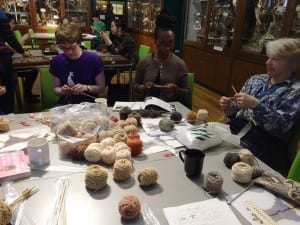
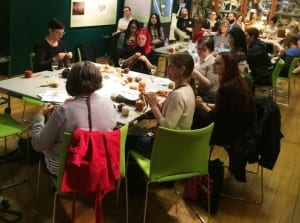

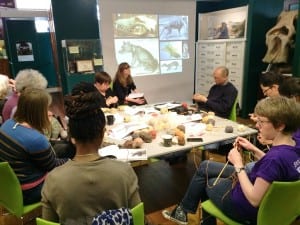
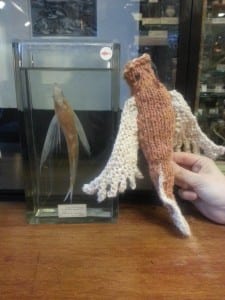

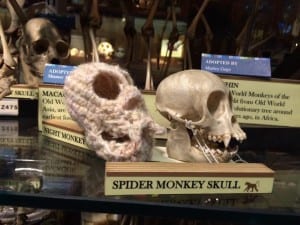
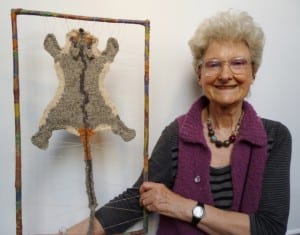

[…] that also contains the Leadbeater’s possum – which has a much reduced membrane (and featured in the form of a knitting kit in our Strange Creatures exhibition) – and the aye-aye-like striped possums. They nest in the […]